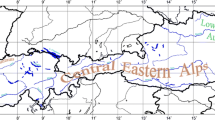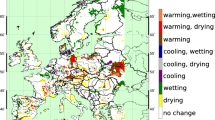Abstract
Making use of the Köppen–Trewartha (K–T) climate classification, we have found that a set of nine high-resolution regional climate models (RCM) are fairly capable of reproducing the current climate in Europe. The percentage of grid-point to grid-point coincidences between climate subtypes based on the control simulations and those of the Climate Research Unit (CRU) climatology varied between 73 and 82%. The best agreement with the CRU climatology corresponds to the RCM “ensemble mean”. The K–T classification was then used to elucidate scenarios of climate change for 2071–2100 under the SRES A2 emission scenario. The percentage of land grid-points with unchanged K–T subtypes ranged from 41 to 49%, while those with a shift from the current climate subtypes towards warmer or drier ones ranged from 51 to 59%. As a first approximation, one may assume that in regions with a shift of two or more climate subtypes, ecosystems might be at risk. Excluding northern Scandinavia, such regions were projected to cover about 12% of the European land area.
Similar content being viewed by others
References
Achberger C, Linderson M-L, Chen D (2003) Performance of the rossby centre regional atmospheric model in Southern Sweden: comparison of simulated and observed. Theor Appl Climatol 76:219–234
Bartholomew JC, Christie JH, Ewington A, Geelan PJM, Lewisobe HAG, Middketon P, Winkleman H (eds) (1988) The times’ atlas of the World. Times, London
Budyko MI (1986) The evolution of the biosfere. Reidel, Dordrecht
Christensen JH, Kuhry P (2000) High-resolution regional climate model validation and permafrost simulation for the East European Russian Artic. J Geophys Res 105(D24):29647–29658
Dequé M, Rowell DP, Lüthi D,Giorgi F, Christensen JH, Rockel B, Jacob, E. Kjellström D, de Castro M, van den Hurk B (2007) An intercomparison of regional climate simulations for Europe: assessing uncertainties in model projections. Clim Change, doi:10.1007/s10584-006-9228-x (this issue)
Doblas-Reyes F, Pavan V, Stephenson D (2003) The skill of multi-model seasonal forecasts of the wintertime NAO. Clim Dyn 21:501–514
Fraedrich K, Gerstengarbe F-W, Werner PC (2001) Climate shifts during the last century. Clim Change 50:405–417
Holdridge LR (1947) Determination of world formations from simple climatic data. Science 105:367–368
IPCC (2000) Emissions scenarios. A special report of working group III of the intergovernmental panel on climate Change. Cambridge University Press, p 599
Jacob D, Bärring L, Christensen OB, Christensen JH, de Castro M, Déqué M, Giorgi F, Hagemann S, Hirschi M, Jones R, Kjellström E, Lenderink G, Rockel B, Sánchez E, Schär C, Seneviratne SI, Somot S, van Ulden A, van den Hurk B (2007) An inter-comparison of regional climate models for Europe:Design of the experiments and model performance. Clim Change, doi:10.1007/s10584-006-9213-4 (this issue)
Köppen W (1936) Das Geographische System der Klimate. In: Köppen and Geiger (eds) Handbuch der Klimatologie, vol I, Part C. Gebrüder Borntraeger, Berlin
Leemans R (1992) Modelling ecological and agricultural impacts of global change on a global scale. J Sci Ind Res 51:709–724
Leemans R, Cramer W, Van Minnen JG (1996) Prediction of global Biome distribution using bioclimatic equilibrium models. In: Breymeyer et al. (eds) SCOPE56 – Global Change: Effects on Coniferous Forests and Grasslands. Wiley, New York
Lohmann U, Sausen R, Bengtsson L, Cubasch U, Perlwitz J, Roeckner E (1993) The Köppen climate classification as a diagnostic tool for general circulation models. Clim Res 3:177–193
Meier HEM, Doscher R, Halkka A (2004) Simulated distributions of Baltic Sea-ice in warming climate and consequences for the winter habitat of the Baltic ringed seal. Ambio 33:249–256
New M, Hulme M, Jones P (1999) Representing twentieth-century space–time climate variability. Part I: Development of a 1961–90 mean monthly terrestrial climatology. J. Climate 12:829–856
Prentice JC, Cramer W, Harrison SP, Leemans R, Monserud RA, Solomon AM (1992) A global biome model based on plant physiology and dominance, soil properties and climate. J Biogeogr 19:117–134
Rowell DP (2005) A scenario of European climate change for the late 21st century: seasonal means and interannual variability. Clim Dyn 25:837–849
Smith GL, Wilber AC, Gupta SK, Stackhouse PW (2002) Surface radiation budget and climate classification. J Climate 15:1175–1188
Thorthwaite CW (1948) An approach toward a rational classification of climate. Geogr Rev 38:55–94
Trewartha GT (1968) An introduction to climate. McGraw-Hill, New York, pp 395–399
Trewartha GT, Horn LH (1980) An introduction to climate, 5th edn. McGraw Hill, New York
Wang M, Overland JE (2004) Detecting Arctic climate change using Köppen climate classification. Clim Change 67:43–62
Author information
Authors and Affiliations
Corresponding author
Rights and permissions
About this article
Cite this article
de Castro, M., Gallardo, C., Jylha, K. et al. The use of a climate-type classification for assessing climate change effects in Europe from an ensemble of nine regional climate models. Climatic Change 81 (Suppl 1), 329–341 (2007). https://doi.org/10.1007/s10584-006-9224-1
Received:
Accepted:
Published:
Issue Date:
DOI: https://doi.org/10.1007/s10584-006-9224-1




